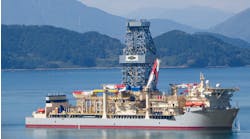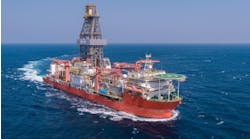Editor's note: This cover story first appeared in the May-June 2023 issue of Offshore magazine. Click here to view the full issue.
By Cinnamon Edralin, Esgian
The global supply of offshore drilling rigs continued to shrink last year, even as demand picked up across multiple regions. At the end of 2021, the total supply of drillships, semisubs, and jackups was 723. By the end of 2022, the total had fallen to 709. Over this same period, the number of rigs under contract increased to 451 at the end of 2022 from 418 at the end of 2021. A total of 254, or 56%, of the rigs under contract at the end of the year were managed by the ten largest rig contractors in terms of managed fleet size for jackups, semisubs and drillships. This is up from 49% of the fleet at the end of 2021.
Sales for conversions, recycling decline
In response to rising demand, rig owners are now less motivated to sell their rigs outside the industry than they have been for the past several years. Almost all of the rigs sold for recycling last year were built before the 1990s. Two notable conversions were confirmed last year. Seadrill sold the semisubs Sevan Brasil and Sevan Driller to New Fortress Energy for conversion to non-drilling units for its LNG business.
Conversely, we saw an increase in rig sales within the drilling industry. Many of these sales were tied to rig contractors in the Middle East going on a buying spree of premium jackups from around the world as they sought to build their fleets to meet demand. Out of the 41 jackups sold for drilling purposes in 2022, only five were jackups not intended for the Middle East market. The four Middle East contractors that purchased jackups last year were ADES, ADNOC, Arabian Drilling, and Shelf Drilling.
One notable purchase transaction involved the merger between Noble Corp. and Maersk Drilling. The UK’s Competition and Markets Authority required the pair to divest some jackups in connection with the merger out of concern for reduced competition in the North Sea. Shelf Drilling, which prior to this did not have a presence in the North Sea, stepped in and acquired five jackups – Noble Sam Turner (to be renamed Shelf Drilling Winner), Noble Sam Hartley (Shelf Drilling Fortress), Noble Lloyd Noble (Shelf Drilling Barsk), Noble Houston Colbert (Shelf Drilling Odyssey), and Noble Hans Duel (Shelf Drilling Perseverance) – for a combined total of $375 million. Shelf then set up an entity called Shelf Drilling North Sea to manage the rigs.
Parent company Shelf Drilling also made one other rig acquisition last year when it purchased jackup Deep Driller 7 from Aban Offshore. The rig is now named Shelf Drilling Victory and is scheduled to start its next charter in the Middle East in 2Q 2023.
Noble Houston Colbert is the only one of the five units purchased by Shelf Drilling North Sea that is currently located outside the North Sea region. The rig has been working off Qatar since October 2022. Its last job in the North Sea was for work in the UK that ended in April 2020. Furthermore, according to the purchase agreement, the jackup Noble Lloyd Noble, which is working off Norway, will continue to be managed by Noble under a bareboat agreement for the duration of the charter.
As mentioned previously, only five of the jackups sold for drilling purposes last year were not targeted for the Middle East. Four were the Shelf Drilling units still in the North Sea, and the fifth was the purchase of a previously retired jackup by US-based White Fleet Drilling for use in the US Gulf of Mexico. This rig has a management agreement with Enterprise Offshore Drilling.
COSL maintains top spot on list
The accompanying table lists the ten largest offshore drilling rig contractors in terms of managed fleet size, meaning the figures include rigs that are managed on behalf of other owners. China’s state-run China Oilfield Services Limited, or COSL, continues to hold onto the top spot on the list with 58 rigs under its management. Second place is also unchanged from the end of 2021, with Valaris managing 46 units at the end of 2021. For clarification, Valaris’s figures do not include units managed by ARO Drilling, which is a 50/50 joint venture with Saudi Aramco. New to the list this year is Advanced Energy Systems, or ADES, which is based in Egypt. Following a string of rig acquisitions, ADES made its debut on the Top 10 list in third place with 45 units under its management.
The Middle East makes a strong showing in the Top 10 as the headquarters of four of the companies – ADES, Shelf, ADNOC Drilling, and ARO Drilling. For the purposes of this article, the Shelf Drilling North Sea fleet is counted under the parent, Shelf. These combined fleets of these four companies represent approximately 18% of the global fleet and 37% of the Top 10 total.
The company that dropped out of the Top 10 list was Maersk Drilling, which was acquired by Noble. At the end of 2021, Noble had the seventh largest managed fleet, with Maersk following in ninth place. The combined fleet now comes in sixth place. In late December 2022, Seadrill announced its intention to acquire Aquadrill. Because the transaction was not finalized until April 2023, Seadrill’s fleet count on the table does not include the Aquadrill fleet.
Fewer rigs under construction
At the end of 2022, 45 rigs remained in the under-construction phase, meaning they had not yet been delivered. The breakdown by rig type is 14 drillships, 6 semisubs, and 25 jackups. Many of these rigs are far along in the construction process and no recent work has been undertaken, as some have been considered stranded at shipyards while seeking new ownership ahead of final outfitting and formal delivery. Last year we started seeing meaningful activity in terms of new bareboat arrangements, purchase agreements, and purchase options for many of the rigs, leaving fewer assets deemed stranded. This activity has carried over into 2023, shrinking the number of stranded units without a manager. The Top 10 managers controlled nearly 22% of the undelivered supply at the end of the year.
The last rig delivered in 2022 was Transocean’s ultra-high-specification drillship Deepwater Titan, which has a five-year contract with Chevron for work in the US Gulf of Mexico that is scheduled to start in the third quarter of this year. At the time of writing, the rig was in transit from Singapore to the US Gulf. This is the world’s first drillship delivered with a blowout preventer (BOP) equipped for pressures up to 20,000 psi. Deepwater Titan is outfitted with two 20K stacks manufactured by NOV. Meanwhile, sister rig Deepwater Atlas, which was delivered in mid-2022, was delivered with two 15K psi BOPs. The rig is scheduled for change-out to 20K capabilities later this year.
Top 10 make strong Middle East showing
Globally, we’ve also seen a decrease in the non-drilling statuses, as a result of demand increasing and more rigs working. Breaking this down by region, the Middle East is where the Top 10 is the most dominant, managing 65% of the fleet, up from 45% last year. The big boost is the direct result of so many purchases of rigs by Middle East contractors seeking to build their fleets.
West Africa has the second biggest showing in the Top 10, although the 63% recorded in 2022 is down quite a bit from 73% the prior year. While the Top 10 companies had nearly the same number of rigs at the end of 2022 as in 2021, with 29 and 30, respectively, more rigs have moved into the region, increasing the supply from 41 to 46, which has brought down the percentage. West Africa was the final portion of the Golden Triangle (Brazil, US Gulf, West Africa) to show signs of demand recovery following the prolonged downturn. Notably, discoveries in the Orange basin off Namibia have seen some rigs moving into, or making plans to move into, the region. Some of this work requires harsh-environment units, which has been a contributing factor in the decreasing offshore rig supply in the Norwegian sector of the North Sea.
The North Sea’s rig supply fell from 76 to 71, with the Top 10 contractors managing 41 units at the end of last year versus 46 at the end of 2021. The North Sea region has faced a double-whammy of slower-than-anticipated demand recovery off Norway, and the implementation of a windfall profits tax in the UK, which has dampened near-term demand and encouraged rig contractors to look to other regions, such as West Africa and Australia, to find new work.
The US Gulf has achieved a relatively stable supply/demand balance. There was little change to the region’s fleet from the end of 2021 to the end of 2022. The total fleet count was unchanged at 44, while the Top 10 companies controlled one fewer rig at the end of 2022 with 22 units under their management. Even though the supply figure was unchanged, the region did have movement of rigs in and out over the course of the year.
More growth expected in Latin America
Latin America has had a lot of attention recently due to Brazil’s Petrobras issuing several multi-rig tenders that are resulting in reactivations of some cold-stacked floating rigs, and the continued drilling successes in Guyana and Suriname. Mexico, on the other hand, has experienced several rig departures, particularly jackups. It has been widely noted that there have been issues with contractors receiving timely payments from state-run oil company Pemex. With growing opportunities around the world and quickly rising dayrates, some rigs have been enticed to other regions. Additionally, several jackups from Mexico were purchased by contractors from the Middle East.
Latin America’s offshore rig supply fell to 98, of which 35 were managed by one of the Top 10 companies, from 108 the previous year, with 34 of those managed by that year’s Top 10. Interestingly, for 2022, the Top 10 companies increased their dominance in the region, representing nearly 36% versus almost 32% at the end of 2021. Keep an eye on this region for rig count growth over the next couple of years, as additional capacity is brought in to meet demand.
Asia-Pacific is another region in which the Top 10 contractors increased their representation in terms of percentage, but in this case, the total number of rigs they managed fell from 104 to 95. This region experienced a decline in supply, dropping from 250 to 226. The primary cause for the supply change is due to Asia-Pacific being home to most of the offshore rig construction yards. Only two of the rigs delivered in 2022 remained in the Asia-Pacific region following delivery.
For 2023, Esgian expects that some of the rigs still in shipyards will receive contract awards, and yard work will resume with an aim to deliver. However, because of global supply chain challenges, rigs that have not yet resumed construction may not be able to achieve a 2023 delivery date, as lead times for parts and equipment are longer than they were at this time last year. Meanwhile, global rig demand is expected to continue to grow, aided by energy security concerns and by operators moving forward with projects made more economical given the strong oil prices the market has seen lately.




